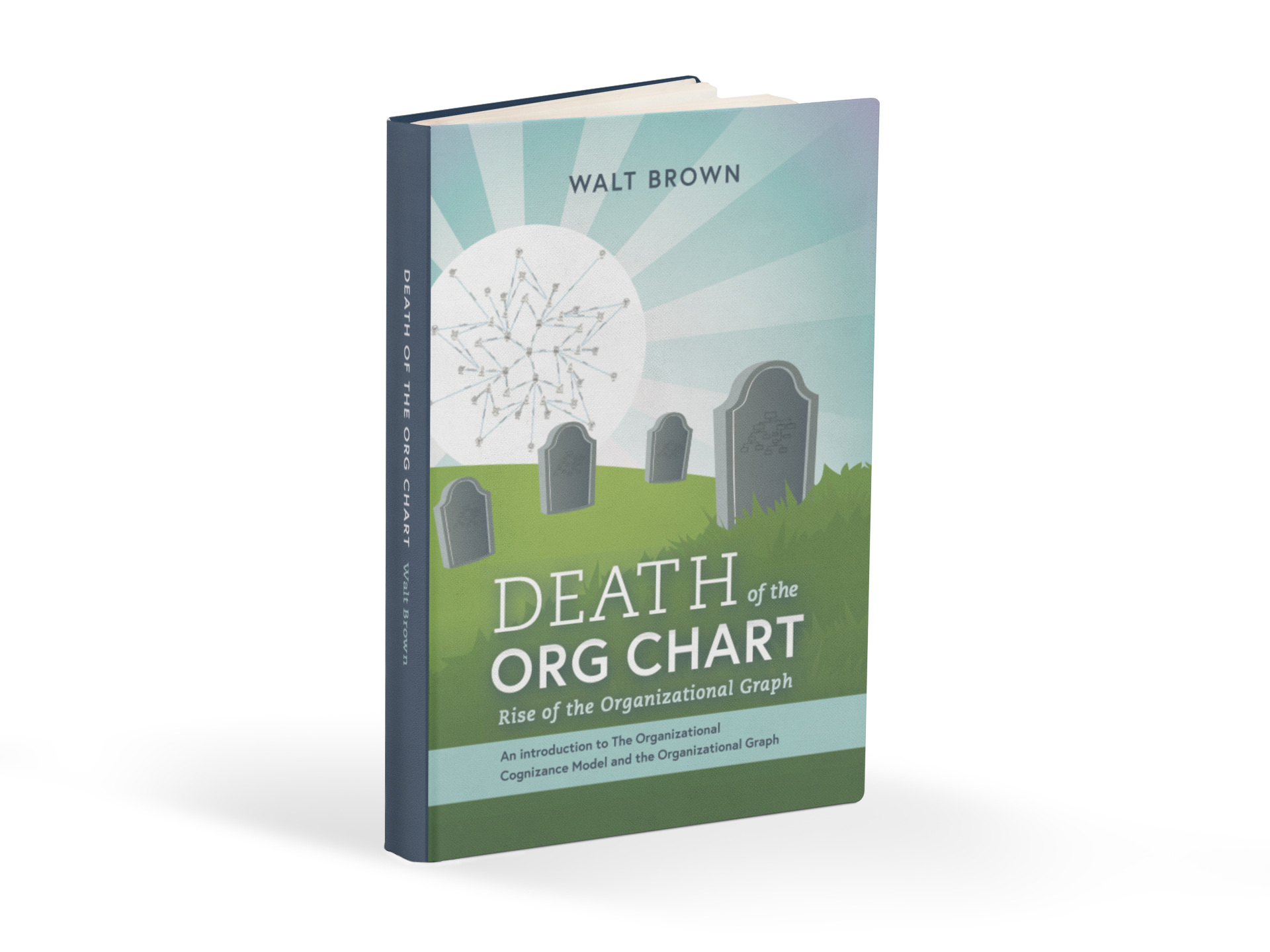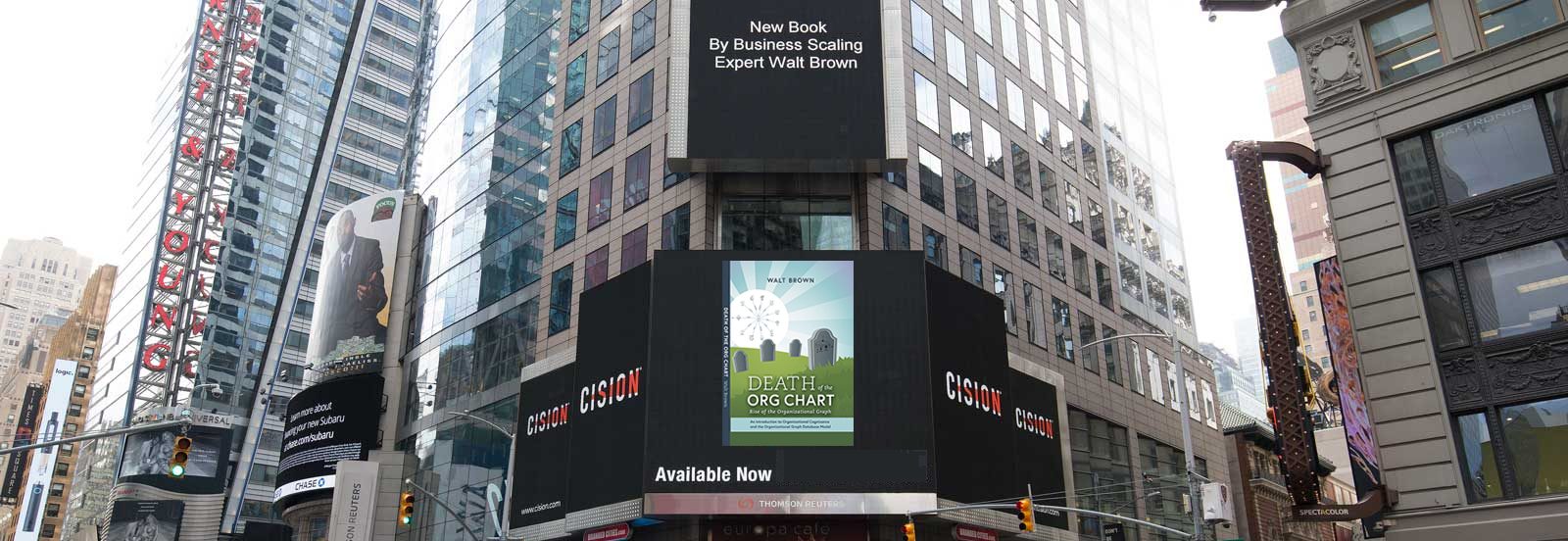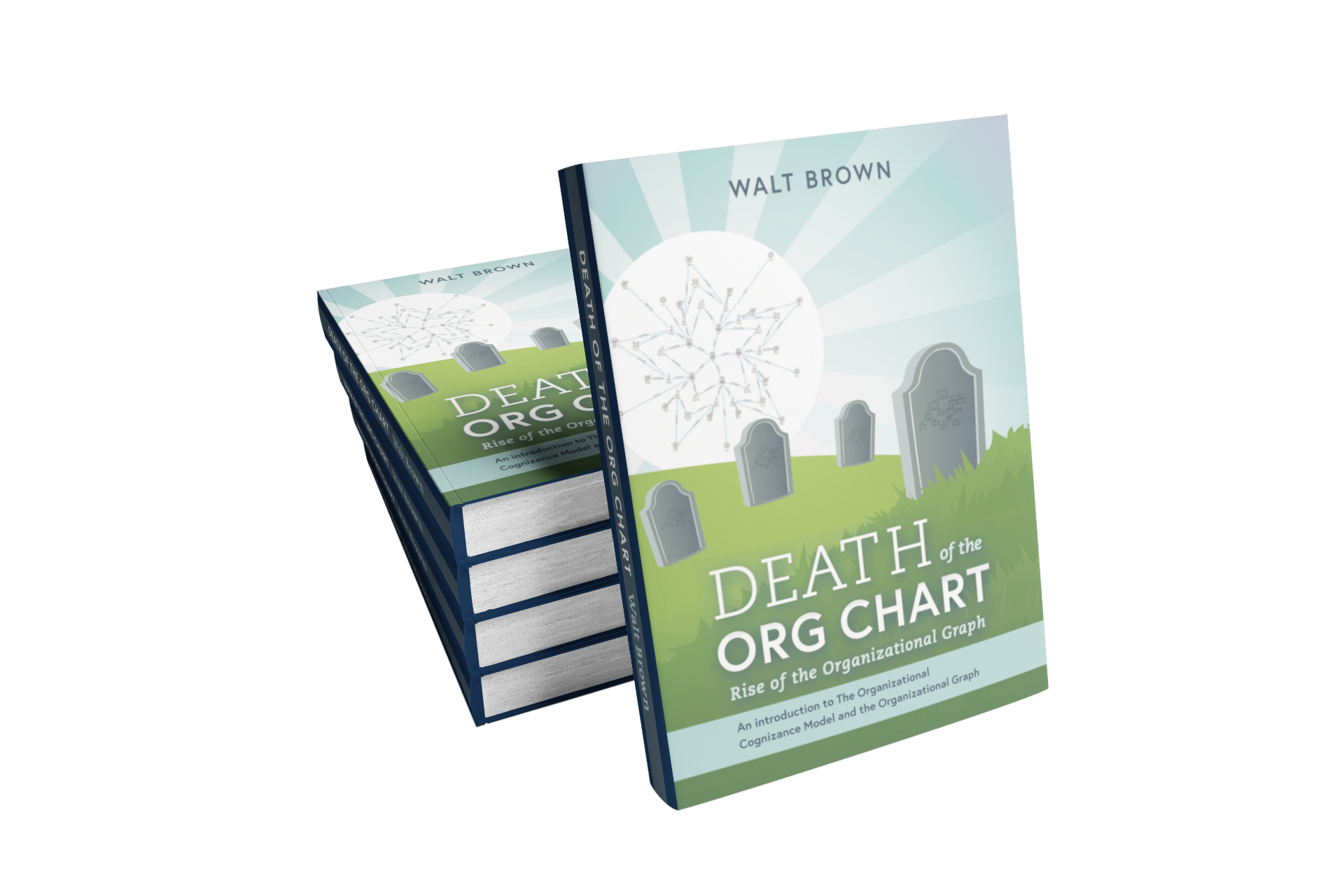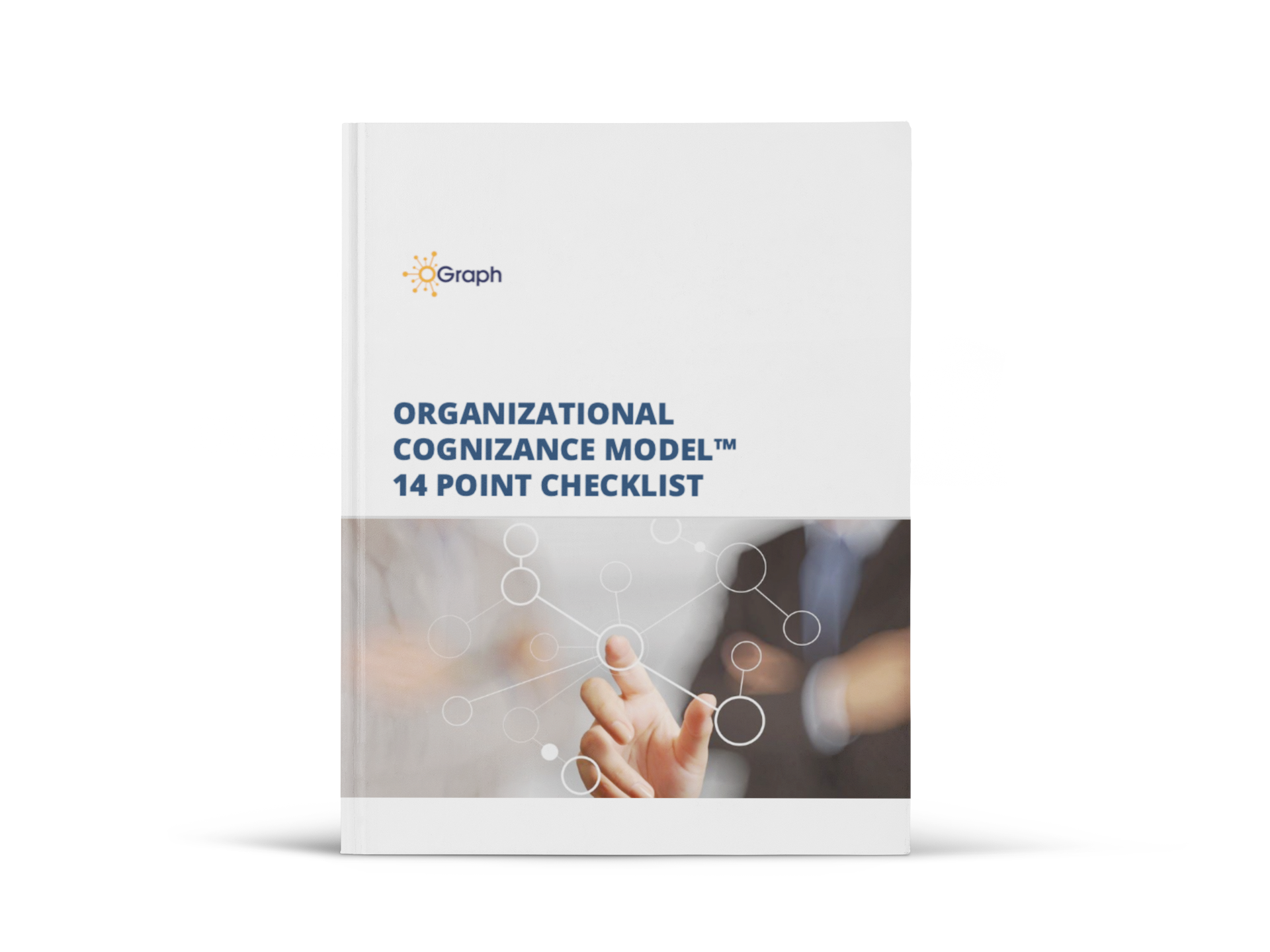
Death of the Org Chart
Rise of the Organizational Graph
By Walt Brown
Do you sometimes feel you are using neanderthal tools and thinking when it comes to org charts and modern organizational structure and design?
If you are thinking this, so are your employees. “A Players”, especially Millennials want to be able to say: “Yes, I understand and embrace what I am accountable for.” Gallup’s Q12 first Employee Engagement question asks: “Do I understand what is expected of me at work?”
In this book, we will teach you how to think about your Org Chart from a modern perspective. You will learn how to unravel and organize the structural complexities inherent in your modern day organization to be sure your employees can answer the questions above positively.
Bonus a Death Org Chart / Graph is your pathway to make Employee On-Boarding self-serve and it is how you will drive measurable positive Employee Retention.
Proven in over 200+ companies since 2006.
Person – Job – Position – Team – Meeting – Entity – Workflow – Process – System – Objective – Key Result – Skill
WHAT IS ORGANIZATIONAL COGNIZANCE?
COGNIZANCE
You are aware when you smell smoke, you are cognizant when you know the smoke you smell is from the cozy fire in the den and not an electrical fire in your wall. We want everyone to be organizationally cognizant, not just aware.
CEO Asks
Who is doing what and why?
Imagine two sides of a coin, on one side your CEO can see and understand why we are hiring a new person – able to see and understand = cognizance.
Individual Contributor Asks
What am I doing, why, and how?
Imagine two sides of a coin, on one side a new individual contributor starting with your company can answer “What am I doing, why and how?”

Book Walt to Speak: “He is the Serious Entertainment”
“Finally a way to get truely organized, to stop reinventing the wheel, a way to STOP WASTING SO MANY RESOURCES!” IS THE MESSAGE of this book.
Average Employee Tenure
Years
Years
Years

Years
Years
The above numbers come from an April 2018 article by Business Insider
The statistics from these hip companies above are actually on the better than average side.
Numbers put out from the Bureau of Labor Statistics show the average has been trending down from 4.1 years and is pointing to 2.8 to 2.9 years.
Do the math, this means 33% of a workforce is new EVERY YEAR.
Does your Org Chart tell you what these 33% were really up to at work?
Does anything wear you out faster than losing a great team member who did so much. but honestly, you weren’t sure exactly what they were doing? How about having to backfill and train missing or new positions? How about not really understanding what so-in-so is really doing? Your Org Chart has let you down.
Have you ever done the $money math to understand the true cost of turnover or on-boarding? One of the really big mistakes is not factoring in the cost to get someone up to speed; cost of trainer time, direct and opportunity cost, both lost forever. How about the length of time to Full Employee Effectiveness measured by ROI, what is it 3 years? What if you could reduce it to 1 year?
Walt is here to help you see how to fix this for good and make more money, have more time, and enjoy less stress.
Insightful, educational, and entertaining, Walt Brown’s message is one of achieving perpetual momentum and freedom.
Specifically, the kind of momentum and freedom that comes when owners and their leadership teams have the guts to create healthy and effective organizations. As an Organizational Strategist specializing in the implementation of Organizational Operating Systems, Culture and Structure, his philosophy is that when we become healthy and effective we naturally create freedom for ourselves, our employees, our vendors, our customers and the world at large. We get good at Attracting, Engaging, Empowering and especially Retaining our A Players by making sure they are structurally and organizationally cognizant.
THE ORGANIZATIONAL COGNIZANCE MODEL™ 14 POINT CHECKLIST™
- I know the Purpose of my Job.
- I know what Positions or “Roles” I fill as part of my Job and I know the Purpose of each of these Positions.
- I know who I Report To.
- I know who I am Mentored By.
- I know who I turn to for Coaching in each of my Positions
- I know what Teams I am Part Of and Why.
- I know what Meetings I Attend and Why.
- I know what Entities (Clients, Projects, Contracts) I Interact with.
- I know what Workflows my Job and Positions participate in.
- I know what Processes I follow and maintain as part of my Job and Positions.
- I know what Systems I login to and Why, and I know how to use them.
- I know the Objectives I am pursuing and how they align with Co. Objectives.
- I know the Key Results I must hit to be doing a good job.
- I know what Skills I need now and in the future.
Learn how to make the above a reality for your company, your organization.
Learn how to turn your Org Chart into a modern Org Graph.
Why Read DEATH OF THE ORG CHART, Rise of the ORganizational Graph?
The Classic Org Chart has reached its limit. 21st Century organizations are much more complex than the reporting structures and diagrams of old can capture.
Death of The Org Chart holds the keys to unlocking the human power inside your Organizational Structure by introducing a new way to look at an organization; empowering individual contributors to own, document, visualize and interact with what they are accountable and responsible for.
A CEO asks: Who is doing what and why?
An Individual Contributor asks: What am I doing, why and how?
Two sides of a coin: Imagine two sides of a coin, on one side your CEO can see and understand why we are hiring a new person and on the other side a new individual contributor starting with your company can answer “What am I doing, why and how?” – both able to see and understand how the answers complete the Organizational Cognizance Model™
Death of The Org Chart is a few things: A Textbook, a User Guide and a Facilitation Guide. 1. It is a textbook for The Organizational Cognizance Model and The 14 Point Checklist ™. 2. It is a user guide for the Graph Database software that allows everyone to document, visualize and interface with the model. 3. It shares step by step facilitations you can use to comb out the details you need for your model.
Brown brings a life-time of running his own companies, coupled with the last 15 years coaching CEOs and helping teams master how they Operate, do Culture, and clarity Structure. Yes, he is an old dude with a young mind.
As a textbook, Death dives deep into Organizational Clarity and Consistency by answering Peter Drucker’s question: Who is doing What? Death unpacks in clear language the complexity of modern day 21st century organizations that most people will never have even considered. This complexity manifests in a solution: The Organizational Cognizance Model that is rooted in the simple and obvious 14 Point Checklist. Death dives deep into the mechanics and psychology of why this is important for you and points the way to how you realize full Employee Effectiveness/ROI.
As a user guide, Death introduces readers to the rising power of Graphs (aka Graph Databases) and how we are upgrading the fading two-dimensional Org Chart with a multi-dimensional Org Graph. Death fully explains the 12 Nodes and 33 Edges that make up the Organizational Cognizance Model and how the data schema works in a Graph. Finally it describes a software that allows every individual contributor to document, visualize and interact with what the OMC Graph is all about.
As a facilitation guide, Death introduces two very detailed facilitations you use to create your full inventory of Positions/Roles that are needed or being filled in your company. Taking and creating this complete inventory is the big hump, the hard work. By using the two facilitations you create more than just an inventory, you will create employee buy-in because you include them in the process. When your people buy-in they do the heavy lifting and your Org Graph will come alive.
Stop the anxiety and $ hemorrhaging, get with the program, become an Org Graph organization and enjoy the rewards of Organizational Cognizance.



YOUR AUTHOR: 200+ Organizations, 2,000+ Days, 15,000+ hours
A SEASONED ORGANIZATIONAL STRATEGIST: WALT BROWN IS NOT PRACTICING ON YOU.
Over the last 15 years, Walt Brown has helped transform the culture and effectiveness of more than 200 organizations across the country through his work helping them create clarity and consistency around Culture, Operations and Structure.
A key discovery of this work has become a belief for Walt and his clients: We believe that an organization is a fiction, a fiction that is only given meaning and power by those who buy-in. If we have 100 people and 51 buy-in to this and the other 49 buy-in to that, then we have two organizations and we have already been divided and we are on our way to being conquered.
Brown teaches that to create one single undivided organization we must have Structural Clarity and Consistency, Operational Clarity and Consistency and Cultural Clarity and Consistency. The combination of these three creates an unstoppable momentum machine.
Learn More About Walt
I BELIEVE IN FREEDOM, HAPPINESS AND SIMPLE THINGS DONE SAVAGELY WELL.
“Seasoned multi-company entrepreneur” is one label that has been used to describe Walt over the years.
Many folks refer to Walt as an entrepreneur, but he insists this is much too generous: “I don’t consider myself an entrepreneur. I consider myself someone who is good at seeing existing patterns and pulling them together in logical ways that people are willing to pay for, then I build teams to serve the pattern.”
Walt believes that, like a waterwheel (powerful, patient, and versatile), a good Organizational Operating System (OOS) captures the source of an organization’s energy and direction, (humans) and then focuses that energy powering your organization. Walt’s Seven Questions and the tools of your OOS are the buckets on that wheel, the fins on the turbine. If you can keep filling those buckets by aligning everyone to yes on the Seven Questions with your OOS, you will harness incredible energy.
Walt is seven for seven when it comes to launching and growing new companies. During the last decade, he has helped transform the culture of more than one hundred fifty organizations across the country as an Implementer of an OOS known as the Entrepreneurial Operating System®. It is his greatest pleasure to work with his clients as they think, plan, execute, observe, adjust, and reflect as they master the skills necessary to permanently enjoy the fruits of a Patient Organization.
One trait that sets Walt’s career apart from others is extreme seasonality. When one is in a seasonal business, two good, bad, and ugly things come with it: 1) The bad and ugly of a seasonal business are extreme cash-flow issues. 2) The good is the off-season when you have time to think, plan, consider a serious change in approach, and then test your execution next season. Walt was cursed but mostly blessed with seasonality, it provided him a unique number of strategic planning reps that honed his understanding of strategic thinking and patience. The built-in patience of those cycles shaped Walt’s business philosophy and his approach to team coaching, which puts patience front and center.
So you can get a sense of his experience, combined, Walt’s 50 largest business clients have 8711 employees, with average sales per employee of $245,786, their average size is $45.5 Million in revenue per year and combined they are doing over $2.2 Billion in sales. Since being becoming Certified Patient Organizations, their employee engagement has consistently risen, employee tenure has increased, and they have doubled their bottom lines and doubled their net free cash flow. Plus they are enjoying life with more freedom. He is typically working with 30 clients across 150 days in a year.
